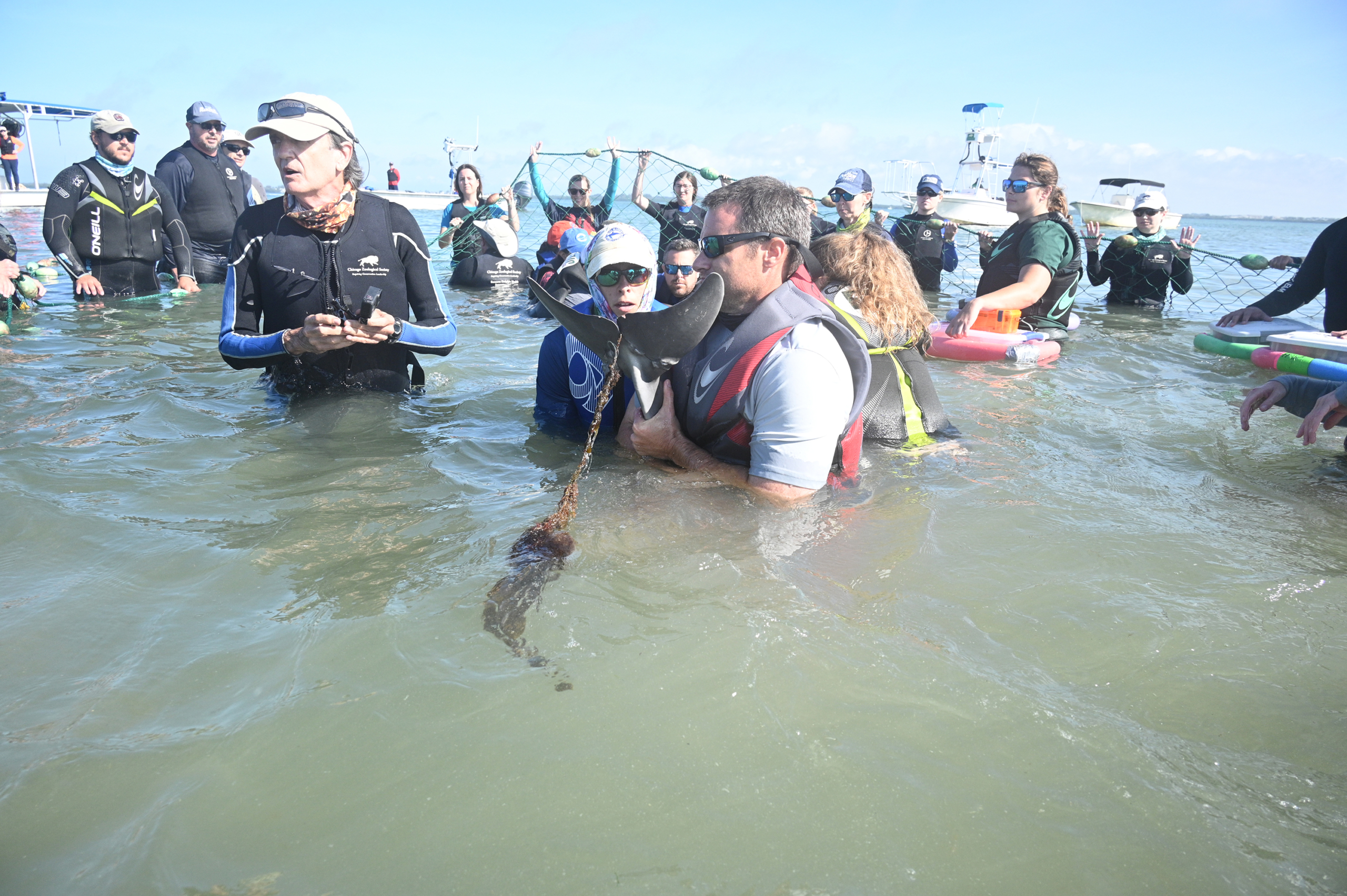Sarasota Dolphin Research Program Leads Effort to Rescue Dolphin Calf from Entangled and Embedded Fishing Gear
A multi-agency team of 51 individuals, including veterinarians, biologists, stranding responders, trained handlers, and law enforcement officers, came together in Sarasota Bay, Florida, on Feb. 21, 2023, to successfully catch, treat, and release a 2-year-old female bottlenose dolphin calf with fishing lines cutting deeply into her tail flukes. The nearly 10 feet of monofilament and micro-multifilament braided lines, which had accumulated an extensive amount of barnacles and algae and other biofouling, were trailing behind the calf, creating drag. The entanglement was pulling the lines deeper into the calf, preventing normal swimming and activities.
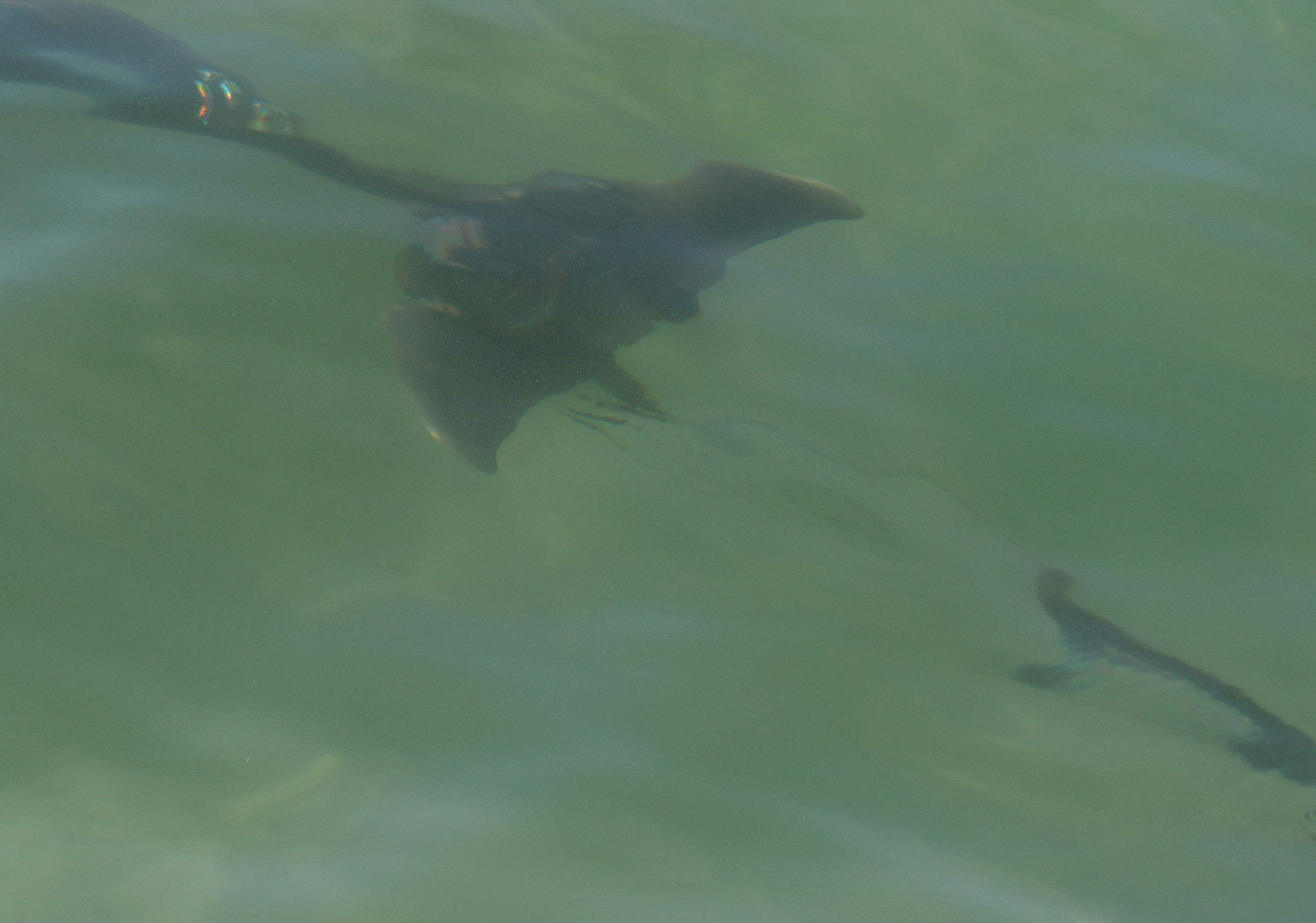
Calf 2094 free-swimming with entanglement.
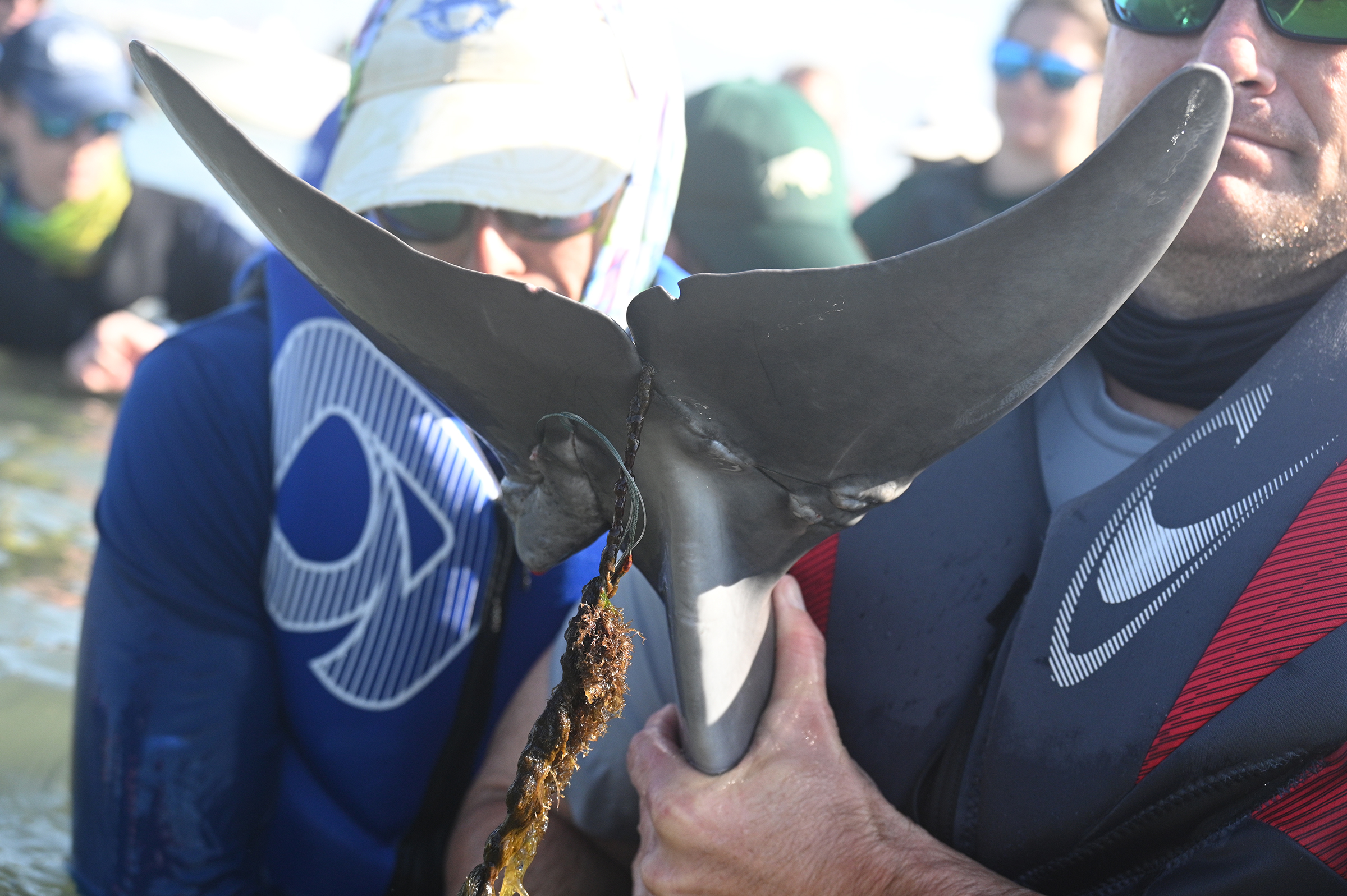
Close up of entanglement on calf 2094.
The calf was first sighted in early January by a tour boat operator. At that time, the National Oceanic and Atmospheric Administration’s (NOAA) National Marine Fisheries Service granted permission to Mote Marine Laboratory’s Stranding Investigations Program and its designee, the Chicago Zoological Society’s Sarasota Dolphin Research Program (SDRP), to attempt a remote disentanglement if conditions were favorable and opportunity arose. Several days after the initial sighting, while performing routine surveys, SDRP staff found the impaired calf and her mom. They were able to remove approximately two-thirds of the line from the calf.
After the line was cut, the pair eluded biologists for the next several weeks and when spotted again a great deal more biofouling had accumulated on the fishing gear. After assessing the calf’s life-threatening situation, NOAA approved a catch-and-release rescue to remove the remaining line. The day before the rescue, the calf was observed no longer using its flukes to swim, but instead was slipstreaming its mother and sculling with its flippers.
The rescue effort was led by the Chicago Zoological Society’s SDRP in collaboration with Mote Marine Laboratory’s Stranding Investigations Program and partners that included Clearwater Marine Aquarium, Florida Fish and Wildlife Conservation Commission’s Marine Mammal Pathobiology Laboratory, Florida Fish and Wildlife Conservation Commission’s Southwest Field Lab, Florida Fish and Wildlife Conservation Commission Law Enforcement, Harbor Branch Oceanographic Institution/FAU, Mote Marine Laboratory and Aquarium Animal Hospital, Sarasota Police Department, SeaWorld of Florida, and University of Florida College of Veterinary Medicine.
In addition to removing the fishing line and debris from the calf, both animals were examined, measured, sampled for blood, and monitored for heart rate and respirations. Additionally, an antibiotic was administered to the calf to help prevent infection and the mother was fitted with a satellite-linked tag so that biologists could continue monitoring the calf’s healing progress. They were released within less than an hour of when they were encircled by the rescue net.
“It is highly likely that without any intervention, the calf would not have survived. The success of this catch-and-release rescue was possible due to the dedication and expertise of each and every individual who participated,” said Dr. Randy Wells, vice president of marine mammal conservation for the Chicago Zoological Society and director of the Sarasota Dolphin Research Program.
Although the removal of the fishing lines was successful, the calf is not out of the woods. The embedded gear caused extensive damage and long-term significant disfiguration to the calf’s flukes. Biologists hope that in time the young marine mammal will be able to make more and better use of its flukes.
Over the years, Sarasota Dolphin Research Program’s staff and its partners have come to the aid of dozens of bottlenose dolphins who have suffered entanglements. Other injuries and deaths from human-related causes include boat and propeller strikes, illegal feeding of wild dolphins, and environmental contaminants.
“When sharing the same space with dolphins and other marine wildlife, it is important to know the best practices for keeping them safe while continuing to enjoy our marine environment,” said Wells. “These include not feeding the animals, reeling in fishing line if a dolphin is nearby, disposing of trash properly, using corrodible fishing hooks, and staying at least 50 yards away from wild dolphins.”
The SDRP conducts the world’s longest-running study of a wild dolphin population. The rescued calf is the fourth offspring of her 19-year-old mother, known as F209. Born in the spring of 2021, she is a fourth-generation member of a resident Sarasota Bay maternal lineage that has been observed by the SDRP since 1971, the year after the program began.
The calf’s rescue was conducted under NOAA permit 24359.
March 8 Update
On March 8, 2094 and F209 interacted with F213 & her calf. The calves spent much of their time socializing and 2094 seemed to have no trouble maneuvering. Her tail wounds appeared to be healing well. We observed the pair again on March 22 and the calf was still doing well.
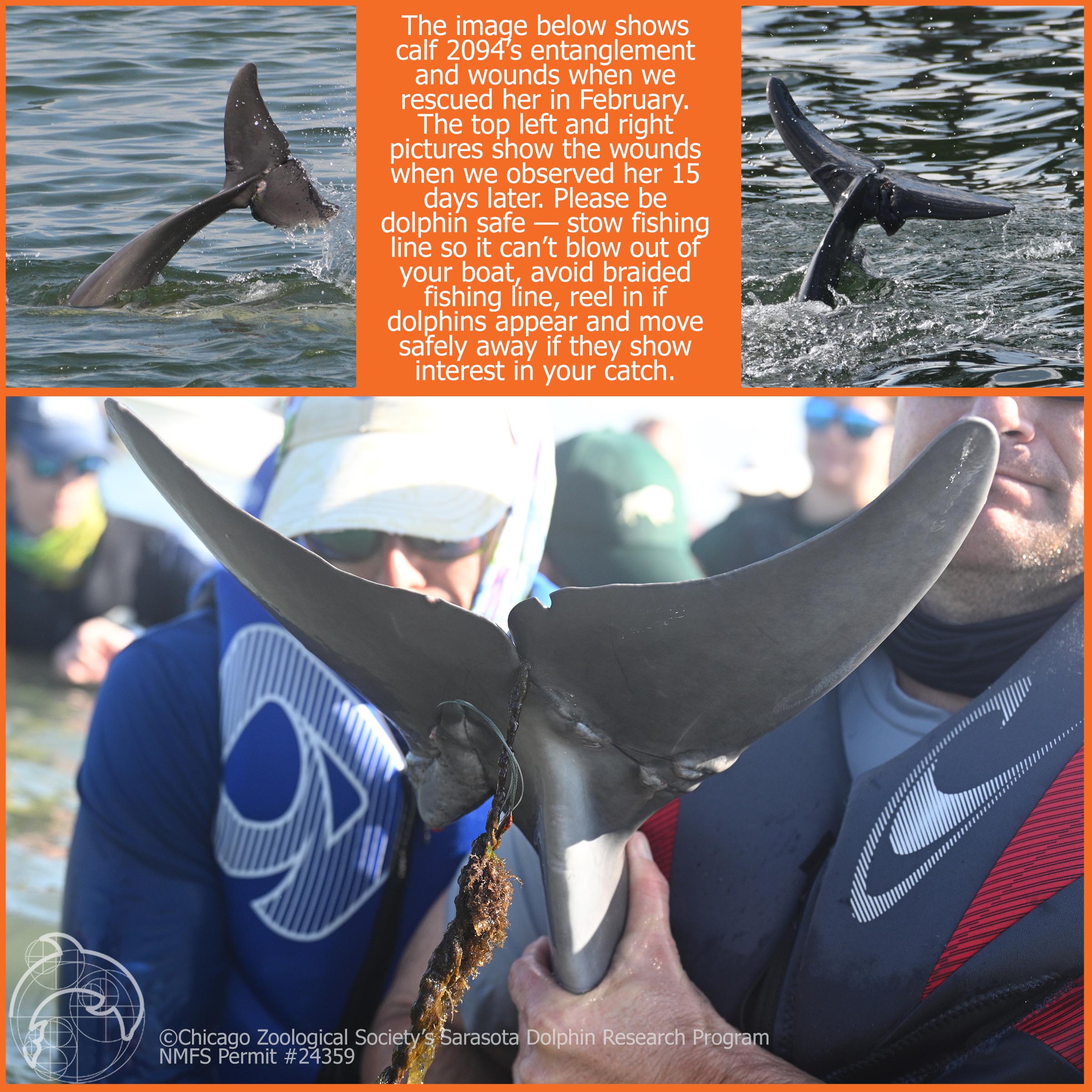
March 27 Update
On Monday, we found 2094 with her mom at the north end of Longboat Key. Our team stayed with the pair for approximately 1.5 hours. They were in the vicinity of other dolphins through most of the sighting, with F209 & 2094 milling near a rock wall. On occasion they engaged in “travel” and “probable feeding” but returned to milling near the rock wall again before the team left them. 2094 seemed to be in good body condition, was using her flukes, and did not appear to have any trouble keeping up with mom. They both did a fair amount of diving with flukes out.
April 3 Update
The team found the calf on April 3. She acquired a large shark bite wound after we last observed her on March 27. She was alongside mom and swimming well. Mom F209 has continued to move through her expected range and survey teams will be out again soon to monitor the pair.
One question we have is whether the severe injury 2094 had to her tail made her more vulnerable to a shark attack. That’s one reason we study sharks along with dolphins — to better understand their predator-prey relationship in Sarasota Bay.
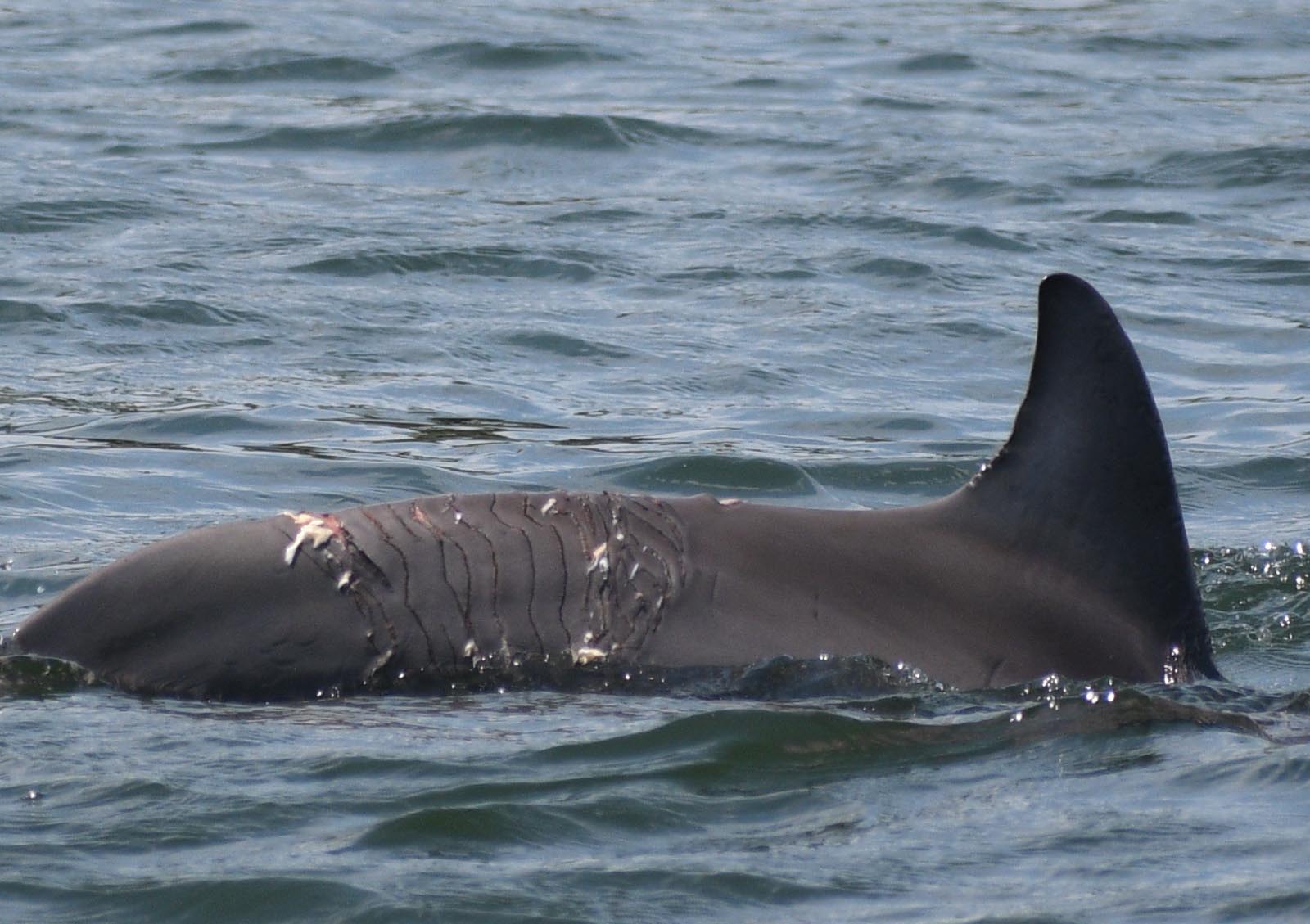
April 4 Update
The team observed the calf again yesterday. She was alongside mom and swimming well, and we observed her pumping her flukes normally as she passed near the boat at high speed. We hope to have survey teams on the water again later this week. Mom continues to move through her expected range.
April 20 Update
The survey team found the mom and calf. While the dolphins were fairly evasive, the team was able to get photos of the shark bite on the calf’s peduncle. It appears that the wounds have been healing well over the past few weeks. The calf was mostly alongside mom, but on occasion moved as far as 15 m away, suggesting normal use of the flukes.




